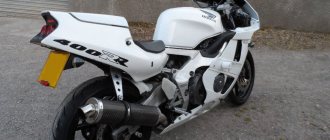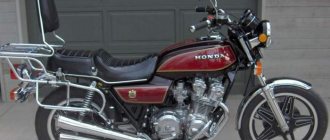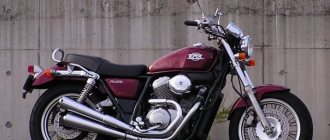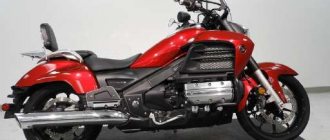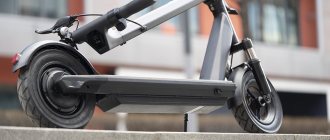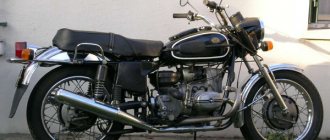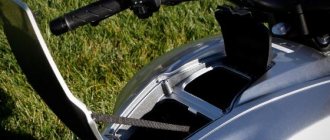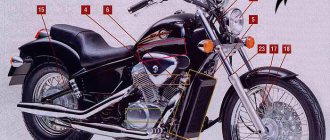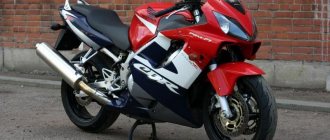For whom
Here are the main features of the Honda CB 900 F Hornet:
- a design that leaves no doubt that it belongs to the class of road builders;
- dynamic performance is quite good for such a middling vehicle;
- ease of landing.
This model is well suited for those looking for a motorcycle for the city. However, if you install a windshield and other touring equipment, you can get something like a touring version of a road bike.
Engine
The model is equipped with an in-line, four-stroke and four-cylinder engine. Its effective volume is 919 cm³. The unit is cooled by liquid. At 6500 rpm the engine produces a maximum torque of 92 Nm, and at 9000 rpm the maximum power reaches 110 hp. The motorcycle's maximum speed is 230 km/h, and it accelerates to hundreds in 3.2 seconds.
Honda Hornet - a motorcycle built for speed
Honda motorcycles The moment when Honda introduces its new Hornet
, have been waiting for quite a long time.
Moreover, even those fans of “bikes” who are not fans and admirers of motorcycles of this series were waiting. The reason for this was simple - Honda promised to present something incredibly powerful and at the same time stylish, which, in principle, it did. In 2007, the company not only introduced a new clone that has more powerful characteristics, Honda introduced a completely new model in all aspects - the Honda CB 600 Hornet
.
There was also quite a lot of interest in this model for the reason that after the presentation of the original model in 1997, the motorcycle immediately became popular and famous. After all, it was a wonderful “bike” with excellent driving characteristics, a very high level of reliability and durability, as well as an acceptable and affordable price.
Appearance and positioning
The difference between the 1997 and 2007 models is huge, in this case the expression “like heaven and earth” would be appropriate. In the 2007 model, not just the concept changed, the positioning in the market was changed. If in 1997 the Hornet was considered a reliable and powerful “horse” that belongs to the mid-price segment, then since 2007 it is not just a powerful and reliable unit, it is a very stylish and extremely modern “bike” with an ergonomic and original design. By the way, in terms of design, we can highlight such points as very well-combined optics, a relief seat, side breaks in the gas tank and, of course, the rear part.
Technical characteristics of Honda CB 600 Hornet
As for the technical components, there are also huge changes. Since now the Honda CB 600 Hornet
2007 is a real streetfighter, then all components must correspond to this status.
Engine
Motorcycles of the Hornet series The engine here is one of the best - CBR600RR
. This unit produces 102 liters. pp., which is a fairly serious indicator. Plus, the motorcycle has an advanced injection system, which provides a very smooth response, as well as accurate distribution of all power, and, of course, increased fuel economy. It is also worth noting that thanks to the new engine, the motorcycle not only became the owner of great power, but also lost five kilograms, which is very good. The engine itself can also be called compact - this has a positive effect on weight distribution.
Mass concentration problem solved!
Engineers from Honda took a fresh look at the problem of mass concentration. Now the exhaust system, which is a four-channel pipeline, reaches only the crankcase, where it forms one single, but large, so-called “can,” from which there is a resonator branch, located under the “belly.” In this way, quite a lot of problems are solved, although new ones also make themselves felt.
Disadvantages of the design - falling is not recommended!
Hornet series motorcycles have always been known as "bikes" that are used to the maximum, which means frequent falls and other damage that the bike itself must be prepared for. So, with such an unusual design, it is quite difficult to imagine what will happen if the muffler comes into contact with the curb asphalt.
Plus, the fact that you shouldn’t fall on this bike is evidenced by the front cast brackets. They are located quite far away, which increases the chances that they can easily break off if dropped. And of course you won’t be happy about this. So it is not recommended to fall on this “bike”, since even a slight fall will require the owner of the motorcycle to take it for repairs.
Honda CB 600 Hornet
New frame
Regarding innovations, it is worth noting the new frame. The CB 600 uses a special backbone frame with aluminum subframes. Thanks to it, high strength is ensured, so even at high speeds you will not have to worry about reliability. Also worth noting is the advanced braking system. At the front there are two discs with a six-piston caliper, due to this you can feel the excellent deceleration dynamics. And all this despite the fact that the total dry weight is only 173 kg.
To summarize, we can say the following: despite the disadvantage in the design, which is not intended for falls and damage, the Honda CB 600 Hornet
- great bike. This is a motorcycle that has excellent performance and also good features that allow you to use it to the maximum.
Dimensions and weight
The length of the bike reaches 2125 mm, its width is 750 mm, and its height is 1085 mm. The wheelbase of the motorcycle is 1460 mm, and its seat height is 750 mm. Not including fuel, the Honda CB 900 F Hornet weighs 200 kg. The tank here is quite large - 19 liters, which allows you to use the motorcycle as a touring one, especially since fuel consumption is about 6 liters per 100 km of road.
Honda CB 900 F Hornet
First generation (2002–2003)
“Hornets” almost immediately became a popular target for various types of upgrades; technomaniacs quickly realized that instead of the standard engine, they could install a motor from a CBR 600 or CBR900RR. Honda took the lead and launched the CB900F Hornet on the market in December 2001. The outlines of the older brother are identical to the “six hundred”, but with a general increase in proportions. A striking feature, valid for all generations, that distinguishes a motorcycle with a 900 cm³ engine is the exhaust system, divided into two mufflers located on both sides of the tail. The Big Hornet’s engine, as you might guess, came from the Honda CBR 900 RR Fireblade, but in a slightly stifled state. The donor engine itself was considered indestructible, and depowering made it almost eternal. In narrow circles, the CB900F Hornet has acquired a bad reputation as a motorcycle that is not for everyone due to its considerable power consumption and engine/suspension imbalance. The powerful, fairly heavy engine really turned out to be too much for the frame, which could be seriously damaged even with a slight fall. A simple fork with a 43mm stanchion diameter and no adjustments works well provided that the rider does not try to explore the motorcycle's limits. Four-piston calipers provide decent braking dynamics, again under normal driving conditions.
Second generation (2004–2007)
In 2004, the model was equipped with a new telescopic front fork with a large number of adjustments. In 2005, the color of the brake calipers changed from black to gold. Other than the color schemes, there were no other changes.
2007 was the final year for the “big Hornet”; in the model line it was replaced by the Honda CB 1000 R, which is no longer a “Hornet”, built on the basis of the engine from the CBR 1000 RR, stylistically and technically made in the spirit of the younger brother CB600F of the latest generations.
Chassis and brakes
The classic frame of this motorcycle is made of steel. It fully corresponds to the ideas about the exterior of this class. Alloy wheels look much more stylish than those on many modern road motorcycles. The steering wheel is typical for a niche.
The rear suspension is pendulum, equipped with a monoshock absorber. At the front, it's a 43mm telescopic fork. The rear brake is represented by a single-piston caliper and a 240 mm disc, while at the front there are four-piston calipers and two discs, each 296 mm.
Number two: 2004 Honda 599.
Typical Honda. In almost every way it is a delightful, lively motorcycle, a bundle of energy that will delight experienced riders, and at the same time is extremely kind and forgiving to beginners. Bold. The real Meg Ryan (before cosmetic surgery) on wheels.
And yet, in typical Honda fashion, there seems to be nothing in the specification sheet to suggest the 599's advantages. It's the only bike with a steel frame, the only one with carburetors, the only one whose suspension is clearly designed for shorter, lighter riders. The suspension is adjustable only on the rear wheel, like the other 600s; the front brakes use old technology with two cylinders and sliding calipers.
The liquid-cooled four-cylinder engine is based on the CBR600F3, which is something to shout about!
You jump up, turn the key, a little gas - oh, how nice - and start it.
Yes, the presence of a carburetor makes the 599 a little cold-blooded, but once warmed up the revs are very good, without any dips that can scare newbies. At higher revs the 599 pulls well throughout the range. Yet the Honda maintains a smooth mid-range torque curve with a sharp jump around 10,000 rpm that defines the torque and power peaks (47.4 and 88.0, respectively). The fact that the supposedly old-fashioned Honda is in the same power group as the newer Triumph is achieved due to good proportions.
In fact, you'll hardly notice any lack of peak power compared to the Yamaha. Part of this is due to the drive - the 599 is less than 0.3 seconds behind the Yamaha in the quarter mile and improves on top-gear acceleration - partly it's a feature; The 599 is rarely underpowered.
Perhaps some of this apparent power parity is an illusion stemming from the Honda's compact dimensions. Sit on it and the 599 feels tiny, just as the 919 looks lightweight next to the huge Bandit, FZ1 and ZRX - with a short steering distance and a seat 60 centimeters off the ground. While not the lightest bike here, it still feels small and nimble. If you were building a bike specifically for beginners and space racers, this is what you would make it.
While certainly easy for beginners, the 599 gives those more experienced a thrill or two. Easy handling - maybe not the same as the Yamaha, but close - and well-tuned damping rates help keep the chassis under control. The shocks are fairly soft, so larger, more aggressive riders may notice some hollowness when leaning forward, especially if the road isn't like a pool table. The cheap suspension (no joke: everyone in this class has cheap suspension) means the 599 doesn't drop as quickly as a sportbike, but you wouldn't expect it to, and the soft springs give the bike the ability to ride well on both the highway and around town. The short wheelbase gives the Honda maneuverability without the fear of losing stability. A very good chassis combined with a good powertrain.
Positioned this way, the 599 is good for newbies, fun for oldies. The motorcycle is impeccably produced and constantly improved. Why didn’t it take first place in our ranking of Japanese six hundred? It's about money, you know. Honda wasn't flattering itself with its category choice when it priced the bike so high at $7,099, almost unattainable. Note that the amount is just $900 higher than the much faster 919 and only $300 lower than the Suzuki Bandit 1200S. “Yeah, but no Honda dealer in their right mind would try to get $7,100 for this bike. The real world price will be significantly lower,” comes the argument from the 599 camp. (In fact, it could be any of us - we all liked the bike.) True, but we can only go by the 2004 MSRP, and if you can knock 10 or 15 percent off the list price at your local Honda dealership, then maybe you can do the same at your Suzuki dealer. Let's put it another way: If the 599 had sold for, say, $6,500 and perhaps had a few more amenities (no center stand, the dash is spartan, and only the headlight is brilliantly bright) it would certainly win this comparison. The question remains: do you want to spend more for a friendlier motorcycle? Let's delve into the soul.
